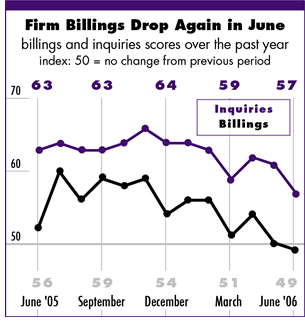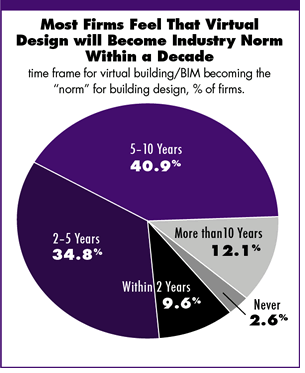

7/2006
Virtual design use spotty at present, expected to be the norm within a decade


by Kermit Baker, PhD,
Hon. AIA
Chief Economist
 Billings at architecture firms declined slightly in June
for the second consecutive month, marking the first two-month national
decline in billings since November 2003. Of equal concern is the slowdown
in growth of inquiries for future projects. Firms reported the slowest
growth of inquiries since August 2003.
Billings at architecture firms declined slightly in June
for the second consecutive month, marking the first two-month national
decline in billings since November 2003. Of equal concern is the slowdown
in growth of inquiries for future projects. Firms reported the slowest
growth of inquiries since August 2003.
Some of the slowdown in design activity may have been weather related, given the unusually rainy conditions in June in much of the country and the variation in business conditions across regions. Billings and inquiries were unusually weak in June at firms located in the Northeast and Midwest. Firms in the South reported strong billings and average inquiries, while firms in the West reported weak billings and very strong inquiries.
Additionally, business conditions in June varied considerably by firm size. Firms with annual billings below $1 million reported very weak billings and inquiries, while larger firms reported stronger conditions. Firms with annual billings above $5 million reported very strong billings and inquiries. Smaller firms tend to concentrate more in the residential sector, so the weak conditions at smaller firms are in large part due to the weakness in the residential sector. Commercial/industrial firms reported solid billings and inquiries, while institutional firms reported strong billings and average inquiries.

The implications of this month’s survey are that much of the recent slowdown in design activity is coming from smaller firms focusing their practice in the residential sector. Firms concentrating in the commercial/industrial and institutional sectors report healthy business conditions, although the pace of growth in business activity at these firms has been slowing somewhat in recent months. Firms should continue to monitor the mood of clients as to whether a trend toward pessimism in future building activity is emerging.
Signs of weakness
The easing in design billings is coinciding with signs of weakness in
the broader economy. Even with a modest uptick in June, national payroll
growth averaged only 108,000 positions per month in the second quarter,
in comparison to 176,000 in the first quarter and 165,000 for 2005.
Construction payrolls actually dropped in June for the first time since
January 2005. Inflation continues to be a problem throughout the economy,
with wholesale (producer) prices up 4.8 percent between June 2005 and
June 2006. With the more volatile food and energy elements excluded,
that figure drops to 1.9 percent, but even these “core” prices
have been on the upswing throughout 2006. With continued increases
in prices, the Federal Reserve Board may choose to raise short-term
interest rates even more.
Some good news is that the manufacturing sector of our economy is showing some signs of improvement with increased foreign demand. Industrial output has increased 4.5 percent over the past year, and this rate has been accelerating in recent months. However, these gains on the manufacturing side may not be offsetting weakness on the consumer side of the economy. Consumer sentiment fell again in July to 83.0 with the preliminary figures from the University of Michigan’s Consumer Sentiment Index. This index is down from 91.2 in January of this year, and 96.5 in July of 2005.
 BIM on the horizon?
BIM on the horizon?
In many circles, virtual design is seen as the wave of the future for
the design professions. This month’s Work-on-the-Boards survey
attempted to gain some perspective on when this is likely to occur.
Currently, only 28 percent of firms have ever used virtual design/building
information modeling (BIM) in the design of a construction project.
Although this percentage does increase with firm size, it still is
only 58 percent for firms with annual billings of $5 million or more,
compared with 20 percent for firms with billings under $1 million,
and 26 percent for firms with billings between $1 million and $5 million.
Over a third of firms (36 percent) plan to increase their use of virtual design over the next year, compared to 49 percent that don’t and 15 percent that are not sure one way or the other. When asked as to when they feel that virtual design will become the “norm” for building design, almost 45 percent think that it will happen within 5 years, and an additional 41 percent feel it will happen between 5 and 10 years.
When asked to give the single greatest obstacle to increased use of virtual design, almost a third (31 percent) mentioned that clients don’t require it and aren’t willing to pay for it. A quarter of firms mentioned that the industry isn’t ready for it yet; that integration across the industry is too difficult. Other factors mentioned by a significant proportion of respondents were: architects not trained to use it effectively (17 percent), too expensive to implement (13 percent), and rewards don’t match the risks (6 percent).
Copyright 2006 The American Institute of Architects.
All rights reserved. Home Page ![]()
![]()
This month, Work-on-the-Boards participants are saying:
• Hard to find qualified folks to hire; it’s a seller’s market
in terms of employees.
• Projects are taking longer from inquiry to start, and construction costs
are much higher and out of line with client expectations.
• Terrible results with bidding costs and ticked-off clients.
• People are not paying bills.
• Our fees are usually based on a percentage of construction
costs, so some savvy clients are reacting to spiraling construction costs
by putting a not-to-exceed ‘cap’ on the maximum fee we can
charge.
![]()